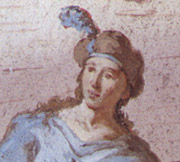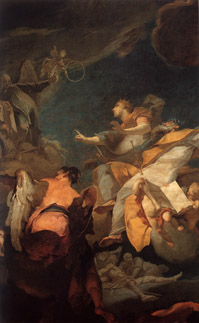
MATTIA BORTOLONI,
a student of Antonio Balestra of Verona, for many years was known only
by the work product of his mature years. On that basis he was considered
a minor master in the shadow, like many others, of Giovanni
Battista Tiepolo.
In 1950, however,
Nicola Ivanoff published in "Mattia Bortoloni e gli affreschi ignoti
della Villa Cornaro a Piombino Dese" (Arte Veneta, 1950,
pp. 123-30) his exciting discovery that Bortoloni was the artist
who had created the beautiful and mysterious 104-panel fresco cycle
at Villa Cornaro-Gable, the Palladian
villa in Piombino Dese. Ivanoff had unearthed in the archives of
the Museo Correr in Venice the original contract between Bortoloni
and the patron Proc. Andrea Antonio Giuseppe
Cornaro (H-39) dated 10 December 1716.
The new attribution
and the dating of the frescos disclosed the youthful Bortoloni (20 years
old in 1716) to have been a precocious and pioneering master. Antonio
Romagnolo observes that the fresco cycle presents "a richness of
new elements that anticipates the rococo of Tiepolo." ("Il Pittore Mattia
Bortoloni" in Mattia Bortoloni, Rovigo, 1987, p. 20)
 Other
examples of Bortoloni's work are displayed at various monuments
in the Veneto and Lombardy, including the parish churches at Castelgugielmo
and Fratta Polesine, and in the ceilings at the Church of S. Nicoḷ
da Tolentino (presbytery, c. 1730) and Villa Vendramin-Calergi.
The collection at the Accademia Museum in Venice contains a study
for the program at S. Nicoḷ da Tolentino, entitled Glory of
S. Gaetano da Thiene (oil on paper, 102 x 56 cm). Ugo Ruggeri
has also identified a painting in the Metropolitan Museum in New
York as a work of Bortoloni, although the museum attributes it to
the French School of the 17th century. ("Nuove Opere di Mattia Bortoloni"
in Mattia Bortoloni, Rovigo, 1987, pp. 55-6.) The Allegorical
Triumph shown here decorates a ceiling in the Museo Ca' Rezzonico
in Venice; a Virgin and Child by Bortoloni is displayed in
that museum's Egidio Martini Collection.
Other
examples of Bortoloni's work are displayed at various monuments
in the Veneto and Lombardy, including the parish churches at Castelgugielmo
and Fratta Polesine, and in the ceilings at the Church of S. Nicoḷ
da Tolentino (presbytery, c. 1730) and Villa Vendramin-Calergi.
The collection at the Accademia Museum in Venice contains a study
for the program at S. Nicoḷ da Tolentino, entitled Glory of
S. Gaetano da Thiene (oil on paper, 102 x 56 cm). Ugo Ruggeri
has also identified a painting in the Metropolitan Museum in New
York as a work of Bortoloni, although the museum attributes it to
the French School of the 17th century. ("Nuove Opere di Mattia Bortoloni"
in Mattia Bortoloni, Rovigo, 1987, pp. 55-6.) The Allegorical
Triumph shown here decorates a ceiling in the Museo Ca' Rezzonico
in Venice; a Virgin and Child by Bortoloni is displayed in
that museum's Egidio Martini Collection.
The self-portrait
above of Bortoloni at age 21 is a detail from one panel of his fresco
cycle at Villa Cornaro.


